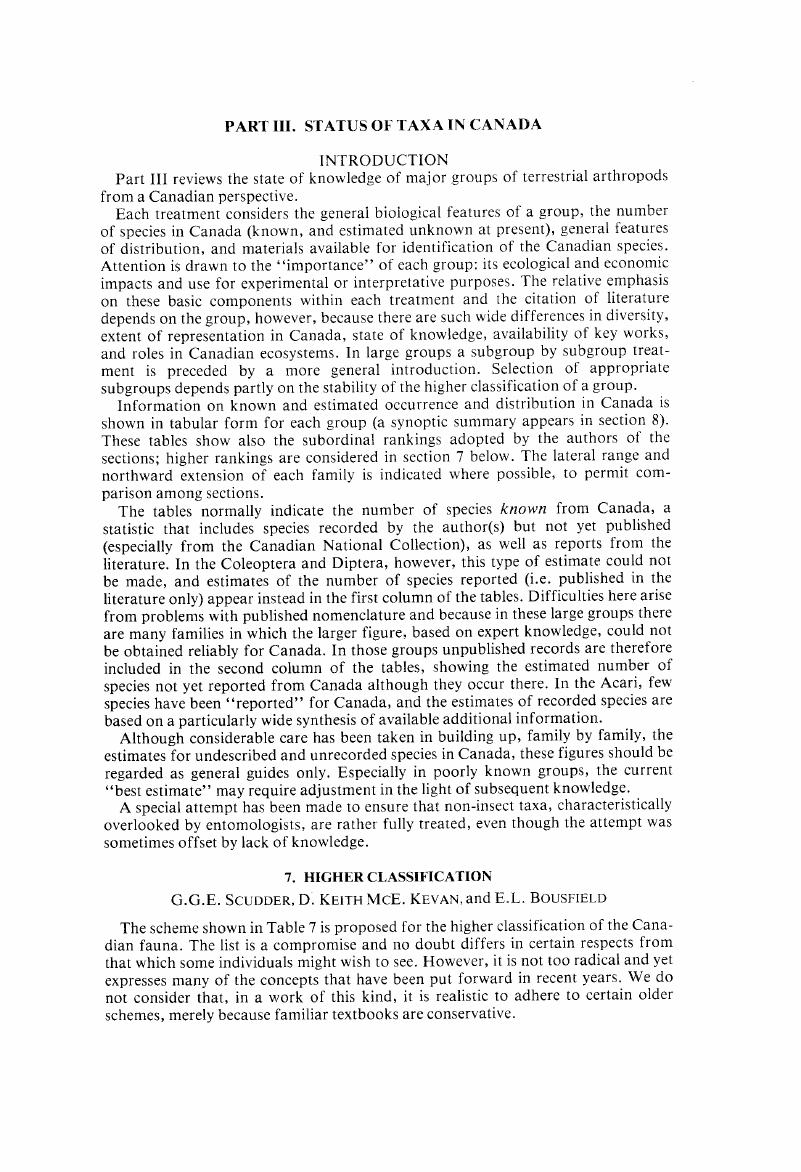No CrossRef data available.
Article contents
HIGHER CLASSIFICATION
Published online by Cambridge University Press: 31 May 2012
Abstract
An abstract is not available for this content so a preview has been provided. Please use the Get access link above for information on how to access this content.

- Type
- Other
- Information
- The Memoirs of the Entomological Society of Canada , Volume 111 , Supplement S108 , 1979 , pp. 235 - 240
- Copyright
- Copyright © Entomological Society of Canada 1979
References
Achtelig, M. and Kristensen, N.P.. 1973. A re-examination of the relationships of the Raphidioptera (Insecta). Z. Zool. Syst. Evol. 11: 268–274.Google Scholar
Ander, K. 1939. Vergleichend-anatomische und phylogenetische Studien Über die Ensifera (Saltatoria). Opusc. Ent. Suppl. 2. 306 pp.Google Scholar
Arnett, R.H. 1963. The Beetles of the United States (A Manual for Identification). Catholic Univ. of America Press, Washington, D.C.Google Scholar
Aspöck, H. and Aspöck, U.. 1971. Raphidioptera (Kamelhalsfliegen). Handb. Zool. 4(2) (2/25): 1–50.Google Scholar
Blackith, R.E. and Blackith, R.M.. 1968. A numerical taxonomy of orthopteroid insects. Aust. J. Zool. 16: 111–131.Google Scholar
Chapman, T.A. 1917. Micropteryx entitled to ordinal rank, order Zeugloptera. Trans. R. ent. Soc. Lond. 1916: 310–314.Google Scholar
Chopard, L. 1949. Ordre des Notoptères Notoptera Crampton, 1915; Ordre des Chéleutoptères Crampton 1915 (= Phasmoptères Jeannel, 1947) in Grassé, P.-P. (Ed.), Traité de Zoologie 9: 587–593; 594–616.Google Scholar
Clay, T. 1970. The Amblycera (Phthiraptera: Insecta). Bull. Br. Mus. nat. Hist. 25(3): 75–98.Google Scholar
Common, I.F.B. 1975. Evolution and classification of the Lepidoptera. A. Rev. Ent. 20: 183–203.Google Scholar
Crampton, G.C. 1915. The thoracic sclerites and the systematic position of Grylloblattodea campodeiformis Walker, a remarkable annectent orthopteroid insect. Ent. News 26: 337–351.Google Scholar
Crampton, G.C. 1921. Remarks on the ancestry of insects and their allies. A. Rep. ent. Soc. Ont. 1920: 105–110.Google Scholar
Crowson, R.A. 1954. The classification of the families of British Coleoptera: superfamily 19: Stylopoidea (Order Strepsiptera auctt.). Entomologist's mon. Mag. 90: 57–63.Google Scholar
Crowson, R.A. 1955. The natural classification of the families of Coleoptera. Nathaniel Lloyd, London. 187 pp.Google Scholar
Crowson, R.A., Rolfe, W.D.I., Smart, J., Waterston, C.D., Willey, E.C., and Wootton, R.J.. 1967. Arthropoda: Chelicerata, Pycnogonida, Palaeoisopus, Myriapoda and Insecta. pp. 499–534in Harland, W.B. et al. (Eds.), The Fossil Record. Geological Society, London.Google Scholar
Dubinin, V.B. 1962. Chelicerata in Rodendorf, B.B. (Ed.), [Arthropods]. [Fundamentals of Palaeontology]. (In Russian.) Akad. Nauk SSSR, Moskva 9: 377–385.Google Scholar
Dugdale, J.S. 1974. Female genital configuration in the classification of Lepidoptera. New Zealand J. Zool. 1: 127–146.Google Scholar
Giles, E.T. 1963. The comparative external morphology and affinities of Dermaptera. Trans. R. ent. Soc. Lond. 115: 95–164.Google Scholar
Hammen, L. van der. 1977. A new classification of Chelicerata. Zool. Meded. 51(20): 308–319.Google Scholar
Hennig, W. 1953. Kritische Bemerkungen zum phylogenetischen System der Insekten. Beitr. Ent. 3: 1–85.Google Scholar
Hennig, W. 1969. Die Stammesgeschichte der Insekten. W. Kramer, Frankfurt am Main. 436 pp.Google Scholar
Hinton, H.E. 1946. On the homology and nomenclature of the setae of lepidopterous larvae, with some notes on the phylogeny of the Lepidoptera. Trans. R. ent. Soc. Lond. 97: 1–37.Google Scholar
Kaestner, A. 1970. Invertebrate Biology, Vol. 3. Crustacea. Wiley, N.Y.523 pp. [English translation and adaptation by H.W. and L.R. Levi of: Lehrbuch der speziellen Zoologie. Teil. 1: Wirbellose. Gustav Fischer, Stuttgart: 659–979.]Google Scholar
Kamp, J.W. 1973. Numerical classification of the orthopteroids, with special reference to the Grylloblattodea. Can. Ent. 105: 1235–1249.Google Scholar
Kevan, D.K. McE. 1973. The place of classical taxonomy in modern systematic entomology, with particular reference to orthopteroid insects. Can. Ent. 105: 1211–1222.Google Scholar
Kevan, D.K. McE. 1977 a. Suprafamilial classification of “orthopteroid” and related insects, applying the principles of symbolic logic — a draft scheme for discussion and consideration. Lyman ent. Mus. and Ent. Lab. Notes 2(ed. 2). 26 pp.Google Scholar
Kevan, D.K. McE. 1977 b. The higher classification of the orthopteroid insects: a general view. In Kevan, D.K. McE. (Ed.), The Higher Classification of Orthopteroid Insects. XV International Congress of Entomology 1976. Section 1. Symposium. Mem. Lyman ent. Mus. and Res. Lab. 4: 1–31, App.(1) - (26).Google Scholar
Kinzelbach, R.K. 1971. Morphologische Befunde an Fächerflüglern und ihre phylogenetische Bedeutung (Insecta: Strepsiptera). Zoologica: 41: 1–256.Google Scholar
Krantz, G.W. 1978. A Manual of Acarology. Oregon State Univ. Book Stores, Corvallis. xx + 509 pp. 2nd ed.Google Scholar
Kristensen, N.P. 1971. The systematic position of the Zeugloptera in the light of recent anatomical investigations. Proc. XIII int. Congr. Ent. 1: 261.Google Scholar
Kristensen, N.P. 1975. The phylogeny of hexapod “orders”. A critical review of recent accounts. Z. Zool. Syst. Evol. 13: 1–44.Google Scholar
Kukalová-Peck, J. 1973. A phylogenetic tree of the Animal Kingdom (including Orders and Higher Categories). Natn. Mus. Can. Publs Zool. 8: 1–78.Google Scholar
Manton, S.M. 1970. Arthropoda: Introduction. In Florkin, M. and Scheer, T. (Eds.), Chemical Zoology 5: 1–34. Academic Press, London and New York.Google Scholar
Manton, S.M. 1972. The evolution of arthropodan locomotory mechanisms. 10. Locomotory habits, morphology and evolution of the hexapod classes. Zool. J. Linn. Soc. Lond. 51: 204–400.Google Scholar
Manton, S.M. 1977. The Arthropoda; habits, functional morphology, and evolution. Clarendon Press, Oxford. 527 pp.Google Scholar
McKittrick, F.A. 1965. A contribution to the understanding of Cockroach-Termite affinities. Ann. ent. Soc. Am. 58: 18–22.Google Scholar
Mutuura, A. 1972. Morphology of the female terminalia in Lepidoptera, and its taxonomic significance. Can. Ent. 104: 1055–1071.Google Scholar
Pesson, P. 1951. Ordre des Homoptères (Homoptera Leach, 1815) in Grassé, P.-P. (Ed.), Traité de Zoologie 10(2): 1391–1656.Google Scholar
Pierce, W.D. 1964. The Strepsiptera are a True Order, unrelated to Coleoptera. Ann. ent. Soc. Am. 57: 603–605.Google Scholar
Poisson, R. 1951. Ordre des Hétéroptères (Heteroplera Latreille, 1810—Frontirostres Fallen, 1814) in Grassé, P.-P. (Ed.), Traité de Zoologie 10(2): 1657–1803.Google Scholar
Remington, C.L. 1954. The suprageneric classification of the order Thysanura (Insecta). Ann. ent. Soc. Am. 47: 277–286.Google Scholar
Richards, O.W. and Davies, R.G.. 1976. Imms' General Textbook of Entomology. 2: 419–1354. Chapman and Hall, London.Google Scholar
Scudder, G.G.E. 1957. Reinterpretation of some basal structures in the insect ovipositor. Nature, Lond. 180: 340–341.Google Scholar
Scudder, G.G.E. 1961. The comparative morphology of the insect ovipositor. Trans. R. ent. Soc. Lond. 113: 25–40.Google Scholar
Scudder, G.G.E. 1973. Recent advances in the higher systematics and phylogenetic concepts in entomology. Can. Ent. 105: 1251–1263.Google Scholar
Sharov, A.G. 1968. [Phylogeny of Orthopteroidea.] (In Russian.) Trudy Pal. Inst. Akad. Sci. USSR 118: 1–217. (Also English version, 1971, Phylogeny of the Orthoptera, Jerusalem.)Google Scholar
Stekol'nikov, A.A. 1967. Functional morphology of the copulatory apparatus in the primitive Lepidoptera and general evolutionary trends in the genitalia of the Lepidoptera. Ent. Rev. 46(3): 400–409.Google Scholar
Zakhvatkin, A.A. 1952. [Division of the mites (Acarina) into orders and their position in the system of Chelicerata.] (In Russian.) Parasitol. Sborn. zool. Inst. Akad. Nauk. SSSR 14: 5–46.Google Scholar


